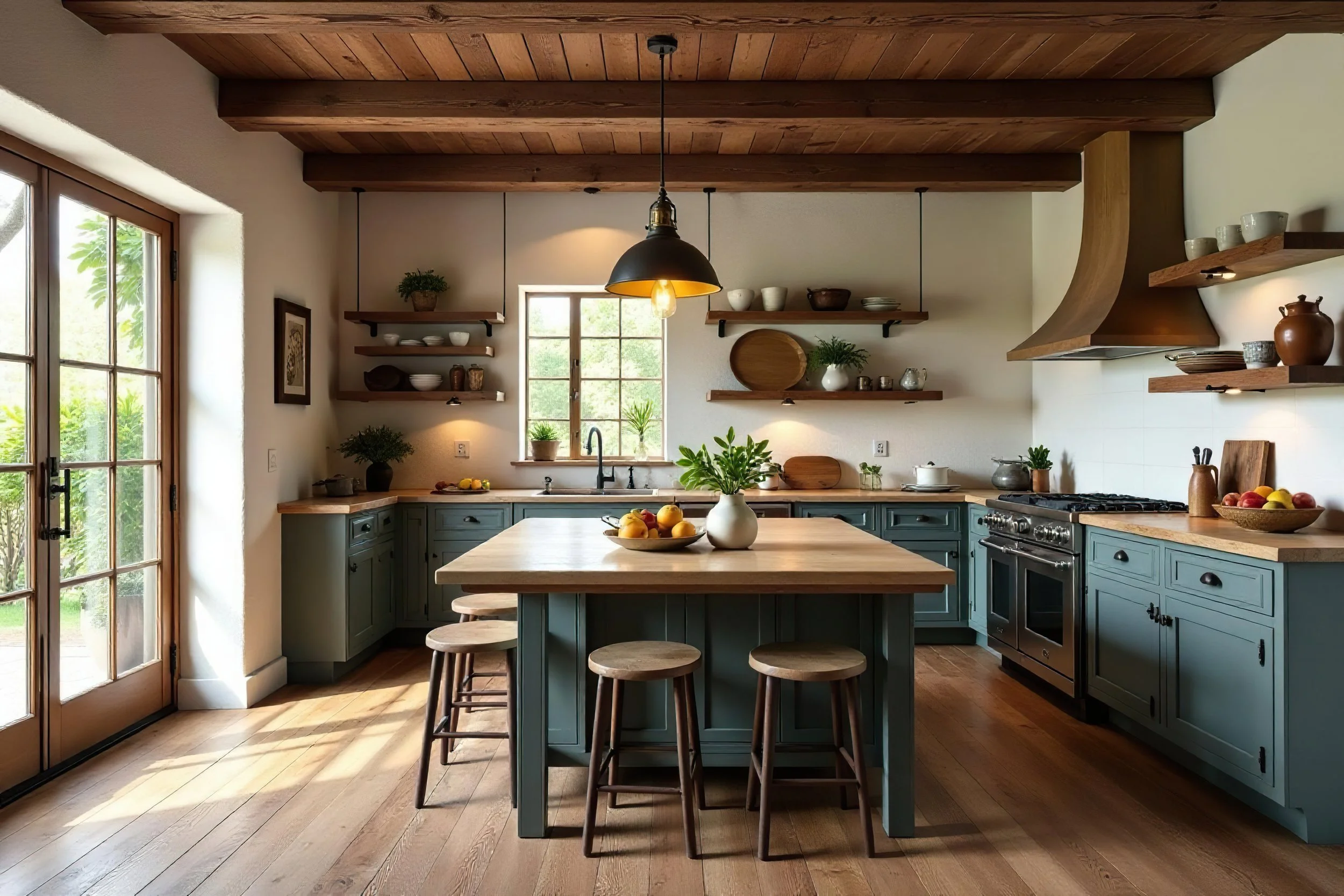10 Ways to Build Historic Charm Into a New Home
SOURCE: Houzz
Well-chosen interior details like intricate moldings and built-ins add character to new construction
Extensively remodeling or building from scratch doesn’t mean your interiors have to feel brand-new. With carefully chosen architectural details and finishes, you can keep all the modern conveniences while capturing the nostalgic charm of a home that has stood for generations. Here are 10 ways to bring old-fashioned character into a new build, illustrated by a mix of houses ranging from the late 1800s to recently constructed. See if you can tell which is which!
1. Use Natural and Reclaimed Materials
Choosing natural and reclaimed materials is one of the most effective ways to give your new home the character of one built long ago — or at least before drywall and formica countertops became the norm after World War II. Wood, stone, plaster, brick and unlacquered metals like brass and copper have inherent warmth and subtle imperfections, and they develop a rich patina over time — qualities that manufactured products often lack.
Reclaimed materials go a step further by bringing actual history into the home. Salvaged barn beams and planks, antique doors, vintage hardware and old brick have authentic weathering and wear that’s almost impossible to reproduce.
That said, reclaimed elements shine brightest when they reinforce your home’s era and style. A stately Queen Anne Victorian, for instance, would have been finished with smooth plaster walls, not rustic barnwood paneling that would be more at home in a farmhouse. Using the right salvaged elements in the right context makes the difference between a house that feels timeless and one that feels disjointed.
Choosing and blending the right old-fashioned details for your home is easier with the guidance of an interior designer or architect — many of whom can be found on Houzz — who understands architectural history, or at least is eager to do the research.
2. Add Decorative Wood Paneling and Trim
Crown molding, picture rails, wainscoting, hand-hewn banisters and balusters and other decorative trim brought dimension and artisanal flair to older homes. Beyond their beauty, these details often served practical purposes, including concealing imperfect seams and protecting plaster walls from scuffs and dents. While modern materials and construction methods make those functions less necessary, trim and paneling still provide a sense of craftsmanship and permanence that can instantly add character to a new build.
Your home’s architecture offers cues for the decorative trim that will suit it best. Victorians and Colonial Revival moldings tended to be taller and more ornate, for example, whereas Craftsman homes often kept trims simpler and chunkier, with visible joinery. These broader architectural styles can be broken down even further into subsets with their own signature details, so it’s important to be on the same page with your designer or architect about which style you’re after and carry it through the house for consistency.
Admittedly, trim made by skilled woodworkers can get costly. But integrating artisanal woodwork of any style into your interior architecture adds individuality and refinement that makes it worth saving up for. If it simply isn’t in the budget, the look can still be achieved by layering historically inspired stock moldings or sourcing salvaged pieces. You can also consider concentrating custom millwork in a few high-impact areas — like an entryway, stairwell or dining room — and using simpler trim elsewhere.
3. Invest in Built-Ins
Built-in cabinetry is another investment that adds abundant character to a newer home. Today it’s considered a luxury, but it was once common in homes of many architectural styles. In fact, functional, furniture-like woodwork, typically crafted from hardwoods and stained to showcase the natural grain, is a defining design element of original Craftsman homes dating to the early 20th century. In Colonial Revival homes from around the same period, built-ins were more often painted and reserved for formal areas, such as the dining room or study.
If a custom woodworking project isn’t in the cards, there are still ways to achieve a similar look. Semicustom or stock cabinetry can be adapted with inset doors and molding to mimic the appearance of built-ins. Even carefully placed freestanding pieces, such as a hutch, a bookcase or a window seat, can create the feeling of integrated woodwork while keeping costs affordable.
4. Consider an Unfitted Kitchen
One room that didn’t tend to benefit from elaborate built-ins before the 1920s was the kitchen. Even in Craftsman homes, kitchens typically combined freestanding furniture pieces, simple wall shelving and sometimes a Hoosier cabinet — a multipurpose cupboard with built-in accessories that became popular in the early 20th century. Unlike the living and dining areas, which were designed as showpieces, kitchens were seen as service spaces, so their cabinetry was all about function.
Unless you’re aiming for accurate historical restoration, you needn’t sacrifice the advantages of a modern kitchen to achieve an old-fashioned, unfitted feel. Pair a freestanding island or hutch with fitted lower cabinets, bring in a vintage cupboard for storage or mix painted and stained finishes so the room feels collected over time. Large modern appliances like refrigerators and vent hoods, meanwhile, can be paneled to blend in with the cabinetry.
5. Focus on Hardware
Much of the charm of an older home comes from subtle, high-touch details that one may not notice at first glance, such as doorknobs, switch plates, window handles and cabinet pulls. In the past, these were often crafted from solid unlacquered brass, iron, porcelain or glass, and they were often more ornamental than today’s typical mass-market hardware.
Some pieces of hardware are more overtly historic, such as keyholes in cabinetry, cremone bolts on glass-front doors or gallery rails on open shelves. Once out of fashion, these designs are enjoying a resurgence thanks to the popularity of English country-inspired kitchens.
Opting for brass or porcelain switch plates instead of plastic and choosing doorknobs with antique styles that fit with your home’s architectural style are great places to start. Architectural salvage companies are excellent sources for antique and vintage hardware, but high-quality replicas can also create a convincing period look.
6. Install Vintage Plumbing Fixtures
Nineteenth-century plumbing can stay in the past, but a claw-foot tub is a throwback worth reviving — and it works with just about any architectural style. Popular from the Victorian era through the 1930s, the originals were cast iron lined with porcelain and could weigh up to 400 pounds. Restored versions are still available, but lighter-weight acrylic or fiberglass reproductions capture the same timeless look without the heft.
Sinks are another plumbing fixture to focus on when you’re trying to achieve a nostalgic feel in your home. In the bathroom, that may mean repurposing an antique sideboard for a console or choosing a vintage-style pedestal or wall-mounted sink. In a kitchen, a farmhouse-style sink, with or without an integrated sideboard, is a versatile choice that’s available in refurbished antique or reproduction designs, and it pairs with most traditional architectural styles.
7. Look to the Ceiling
From the rough-hewn beams and pressed tin ceilings in modest houses to the coffered ceilings and ornate medallions in grand ones, ceiling treatments routinely added architectural flair to homes until the early 20th century. They often varied in height too — dropping to 7 feet in secondary spaces like kitchens and rising to 12 or 14 feet in main living areas.
To recapture some of that character today, don’t default to flat, uniform 8- or 9-foot ceilings. Instead, discuss period-appropriate ceiling heights as well as treatments with your architect during the planning stage.
8. Don’t Forget Flooring
Wood, stone and tile have been used in flooring for centuries, and linoleum — an all-natural, environmentally friendly alternative to modern vinyl — was invented in the mid-1800s. But while flooring materials haven’t varied much over the years, their designs have.
Checkerboard and encaustic tiles were favorites in 19th-century homes, while hexagonal mosaics became standard in early-20th-century bungalows and Colonial Revival houses. In finer homes, the designs tended to be more intricate, whereas modest homes might have used the same materials but in simpler patterns, or linoleum in place of tile.
Wood flooring also varied. True Colonial houses and farmhouses often used very wide planks (up to a foot wide), while Craftsman and Colonial Revival styles typically featured narrower boards (2 to 3 inches wide). You’d likely find intricate parquet and inlaid wood patterns in Victorians, Tudors and other grand houses.
Today, you can add historical character by drawing from those traditional designs. But simple wood floors, black-and-white mosaics or subtle checkerboard patterns are a safe bet for a wide range of traditional homes.
9. Dress Up Your Doors
Homes built before World War II are often described as feeling more “solid” than newly built homes — and in some cases, that’s literally true. Their interior doors were made of solid wood, which outperforms today’s inexpensive, lightweight, hollow-core interior doors in both insulation and sound dampening.
Often, doors featured transom windows above them to allow for air circulation and to let sunlight reach interior rooms. Single and double pocket doors were also common from the Victorian era through the early 20th century, and they add both charm and functional separation between rooms today. In Craftsman and Victorian homes, doors commonly featured beautiful inset leaded and stained-glass panels.
When choosing doors for your home, opt for solid wood designs — or at least solid-core versions — that align with your home’s architecture. Four- or five-panel doors work in many early-20th-century styles, while simpler plank doors suit farmhouses and cottages. Salvaged antique doors are readily available too. Don’t forget to complete the look with period-appropriate hardware.
10. Let Surface-Mounted Lighting Shine
Recessed lighting — commonly called can or pot lights — became popular in homes in the 1960s. Since then, LED technology has made them much more discreet and efficient, and they’re ideal for task lighting over sinks, countertops and desks, as well as for spotlighting architectural features. However, a ceiling peppered with numerous can lights is a clear sign of a newer home.
In contrast, older homes relied primarily on a combination of portable lamps and surface-mounted fixtures, including pendants, flush and semiflush mounts and wall sconces.
Colonial Revival homes often featured simple brass or nickel pendants, symmetrical wall sconces or lantern-style lights. Victorians favored etched or frosted glass globes, while Tiffany-style lamps and warm copper or bronze fixtures were hallmarks of Craftsman homes. Tudor Revival houses typically relied on wrought iron lighting. Despite these stylistic differences, the common thread was that the fixtures provided flattering, layered lighting and often functioned like jewelry throughout the home.
By using small, inconspicuous recessed lights only where needed and layering in period-appropriate fixtures elsewhere, you can create an old-fashioned ambiance without sacrificing functionality.
SOURCE: Houzz

